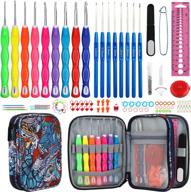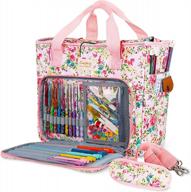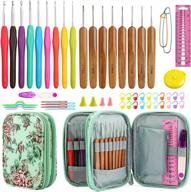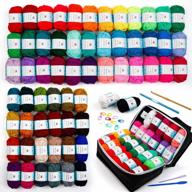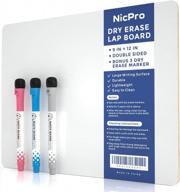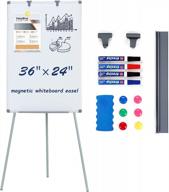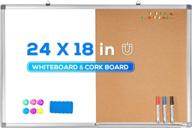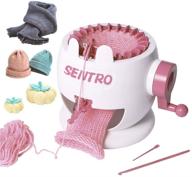The Easiest Way to Get Started with Knitting Looms
Knitting looms are a great way for beginners to learn how to knit without struggling with needle coordination. Looms have pegs or posts where you wrap your yarn to create stitches. It's an easy, intuitive technique that anyone can pick up. Here's a step-by-step guide to get started with knitting looms.
Choose a Knitting Loom
First, select a knitting loom. Some good options for beginners include:
- Round plastic knitting looms - These have pegs arranged in a circle and are used to knit hats, socks, sleeves, etc.
- Rectangular loom boards - You can make scarves, shawls, blankets, etc on a rectangular knitting board.
- Long loom boards - Longer looms allow you to make extra wide projects like afghans.
Consider the project you want to make and choose a loom accordingly. Most come in a variety of sizes and peg counts.
Similar products
Get the Needed Supplies
In addition to a knitting loom, you'll need:
- Yarn - Choose an appropriate weight for your project. Worsted weight is a good starter yarn.
- Knitting hook or crochet hook - Used to wrap yarn around pegs.
- Removal tool - Helps remove finished pieces from the loom.
- Scissors
Set Up the Loom
Take your knitting loom out of the package and make sure the pegs are pushed all the way down into the base so the tops are flush.
Another interesting products
Wrap the Yarn
Now you're ready to start wrapping! There are a few ways to begin:
- E-wrap method - Take the yarn behind the first peg, wrap around to the front and cross it over the top.
- Figure 8 method - Wrap the yarn around two adjacent pegs in a figure 8 pattern.
- U-wrap method - Take the yarn behind and over the top of the peg in a U shape.
Check knitting loom instructions to see which wrap method is recommended. Wrap the yarn around each peg until you reach the end of the row.
Work the Next Row
When your loom is wrapped, turn the work around so you can access the other side. Use your knitting hook to lift the loops from the pegs on the completed row up and over the top. This locks them into place. Then wrap the empty pegs with yarn to create your next row.
Bind Off the Loom
When your project is the desired length, bind off to finish. Cut your yarn, leaving a tail. Use a crochet hook to lift each loop off the pegs and over the loop next to it to bind off.
That's it! Now you know how to use a knitting loom to create beautiful handmade projects with ease.
Must-Have Knitting Loom Patterns for Beginners
Once you've learned the basics of working with a knitting loom, you'll be eager to start making projects! Knitting looms are beginner-friendly, so you can make impressive handmade items even as a novice. Here are some of the best knitting loom patterns for getting started:
Basic Hat
Hats are one of the most popular projects for loom knitting. Try this basic hat for your first piece:
- Loom: Round plastic loom, minimum 36 pegs
- Yarn: Worsted weight acrylic or wool yarn
- Stitches: E-wrap or figure 8 stitch
Just wrap the pegs until the hat is the desired length, then gather the top and finish with a pom pom for a cute accessory!
Top products in 🧵 Knitting Looms & Boards
Simple Scarf
Scarves are easy even for absolute beginners on a knitting loom. You'll need:
- Loom: 24-peg rectangular loom
- Yarn: Worsted weight acrylic or wool yarn
- Stitches: E-wrap, figure 8 or U-wrap stitches
Knit until the scarf reaches the wanted length. Finish with tassels or fringe for a nice touch.
Bulky Knit Blanket
One of the fastest projects for a loom knitting beginner is a chunky blanket. Try this pattern:
- Loom: Large gauge loom with a minimum of 50 pegs
- Yarn: Bulky #5 weight yarn
- Stitches: E-wrap stitch
Choose a chunky blanket yarn in your favorite color and get ready for a quick, cozy knit!
Simple Stocking Cap
| Supplies | Instructions |
|---|---|
|
|
A quick, easy project for making a winter hat on a round loom!
Infinity Scarf
The infinity or mobius loop scarf knits up fast. Use a long loom or board and bulky yarn.
With these simple beginner patterns, you'll be a pro at loom knitting in no time!
How to Choose the Right Knitting Loom for Your Projects
With so many options available, it can be tricky to figure out which knitting loom is best suited for your project. Here are some tips on selecting the right loom size and type:
Consider Your Planned Project
The knitting loom you need depends on what you want to make. Some guidelines:
- Round looms - Best for hats, socks, sleeves, cowls, purses, etc.
- Rectangular looms - Ideal for scarves, shawls, blankets, etc.
- Long/wide looms - Good for extra chunky blankets and wide projects.
Think about the final shape and size you need and choose a loom accordingly.
Loom Size Matters
Pick a loom size suitable for your finished piece. For instance:
- Standard adult hat - 36-48 peg round loom
- Chunky infinity scarf - 48+ peg round loom
- Baby blanket - Minimum 31x31 peg rectangular loom
Review project dimensions and recommended loom sizes before purchasing.
Account for Gauge
Gauge (stitches per inch) determines the density of your finished knitting. Larger gauge pegs and yarn will knit up faster but be less dense. For tight, dense knits, choose:
- Smaller gauge loom
- Thinner yarn
- Tight stitch pattern like the U-wrap
Material Considerations
Looms come in plastic, wood, and metal materials. Considerations:
- Plastic - Lightweight, affordable option good for beginners
- Wood - Provides more friction for yarns to grip and has natural appeal
- Metal - Very smooth finish, best for advanced knitters and slippery yarn
Learn Loom Specifics
Research loom features before purchasing:
- Adjustable vs. fixed peg distance - Adjustable allows more flexibility
- Slotted vs. hole pegs - Holes provide more yarn control
- Removable vs. fixed pegs - Removable makes removing projects easier
- Accessory grooves - Allow use of end pieces and other accessories
Choose features suited to your skill level and project needs.
Pick Your Peg Shape
Peg shape impacts how the yarn grabs. Options include:
- Straight pegs - Good yarn grip, work for most projects
- Pointed pegs - Allow easier stitch glide for intricate patterns
- Twisted pegs - Excellent yarn control and traction
Evaluate peg shapes when selecting a loom for the first time.
With the right loom choice, you'll be creating beautiful knitted pieces in no time!
Biggest Knitting Mistakes to Avoid When Using Looms
Knitting on a loom makes projects fast and easy. However, there are still some common mistakes that beginners make. Avoid these pitfalls for smooth sailing with your loom knitting:
Choosing the Wrong Size Loom
Using a loom that’s too small or too large for your project can ruin the final result. Be sure to:
- Check gauge specifications for all patterns
- Measure your work as you go to ensure proper sizing
- Use a gauge tool to confirm stitches per inch if needed
Inconsistent Yarn Tension
Uneven yarn tension leads to irregular, messy knitting. Prevent this by:
- Wrapping yarn at a consistent, moderate tension
- Avoiding pulling too tight or leaving stitches too loose
- Using a knitting buddy for help maintaining tension
Failing to Keep Yarn Strand Behind Pegs
For most techniques, the working yarn should pass behind the pegs. Exceptions:
- E-wrap: Yarn goes behind first peg, then over top.
- Figure-8: Yarn wraps around front of pegs.
Check instructions for proper yarn direction to keep strands tidy.
Incorrect Stitches for Chosen Loom
Stitch patterns like e-wrap or u-wrap work best on certain loom shapes. Using the wrong stitch can impede project flow. Always:
- Research which stitches pair best with your loom style.
- Use stitches recommended in pattern instructions.
- Practice unfamiliar stitches before starting projects.
Failing to Join New Yarn Properly
When adding new yarn, avoid leaving loose strands inside the knitting where they’ll show. Instead:
- Overlap new and old yarn ends and knit a few stitches through both.
- Or, weave ends into finished knitting using a tapestry needle.
Not Binding Off Correctly
Binding off finishes edges neatly. Avoid sloppy borders by:
- Following bind off instructions carefully for chosen stitch.
- Keeping bind off tension moderate, not too loose or tight.
- Binding off with the same gauge tool used to knit the project.
Removing Projects Incorrectly
Don’t cut pieces directly off the loom or stitches may unravel. Instead:
- Use a bind off technique to finish edges securely.
- Carefully remove with a loom pick to avoid snags.
- Block pieces to shape and size them after removing from the loom.
Avoid these common knitting mistakes for picture perfect projects off your loom!
Tips for Getting Even Tension on Your Knitting Loom Creations
Inconsistent, uneven tension is one of the most common problems for beginner loom knitters. However, getting nice even tension just takes some practice and technique adjustments. Follow these tips and tricks to improve the look of your loom knitting:
Check Your Yarn Tension
Wrapping the yarn too tightly or too loosely around the loom pegs creates uneven stitches. Try to maintain a moderate, consistent tension as you wrap. For example, wrapping tightly may create a hat that fits snugly but has irregular, wavy edges along the brim.
Use Your Fingertips
Letting the yarn run through your fingertips helps control tension. The slight friction helps even out the tension. For instance, you can hold the strand between your thumb and index finger as you wrap yarn across a knitting board.
Invest in a Yarn Tension Ring
Special tools like a tension ring keep tension steady as you knit. The ring slips over your finger and has a hole the yarn passes through to create the ideal amount of tension for smooth wrapping.
Wrap in Front and Back
On looms with pegs in vertical rows, wrap the pegs in alternating front and back rows. This evens out tension across both sides rather than overly tightening one side. For example, knit the rows of a scarf by wrapping the front pegs from right to left first, then the back pegs from left to right.
Take Breaks to Check Tension
Periodically stop and examine your knitting for even tension across all pegs. Look for gaps, loose wraps, or irregular stitches. Adjust your wrapping technique as needed to correct any inconsistencies before continuing. This helps prevent tension issues from accumulating.
Block Your Finished Pieces
Blocking helps finished knits maintain their shape and smooths out tension problems. Pin your washed and damp knitting piece to a blocking board, mat, or other surface and let air dry to relax the fibers into an even fabric.
Match Yarn to Loom
Make sure your yarn weight and fiber work well with the loom style, material, and peg shape. Yarn that sticks and grabs on the pegs makes it harder to maintain even tension as you wrap. Using very slippery yarn like silk on a smooth plastic loom can also make consistency challenging.
Check Gauge Frequently
Use a gauge tool or ruler to frequently measure stitches per inch as you knit. This allows you to spot and fix any areas with looser or tighter stitches. Simply count the number of stitches in one inch width and compare to your target gauge.
With attention to technique and consistent practice, you’ll be able to create beautiful, even knitting off your loom in no time!
How to use your Amazon Prime to buy "Knitting Looms & Boards"
Amazon Prime offers fast, free shipping and great prices on all kinds of items, including knitting looms and boards. Here's how to use your Prime membership to purchase knitting supplies and accessories:
Search for Knitting Looms
Go to Amazon.com and type "knitting looms" or "knitting boards" into the search bar. You can also browse for items in the Arts, Crafts & Sewing section under Knitting & Crochet > Knitting Looms & Boards.
Filter by Prime Eligible
Once search results populate, check the box next to "Prime Eligible" under the price filter on the left side. This will filter products to only those eligible for Prime's free 2-day shipping.
Compare Loom Options
Browse through the Prime eligible knitting looms and boards. Look at pictures, sizes, materials, and peg type. Read through customer reviews and product details to evaluate your options.
Add to Cart
When you find a knitting loom set or board you want, simply click "Add to Cart." Items eligible for Prime shipping will be clearly marked.
Checkout with Prime
When you proceed to checkout, the items in your cart eligible for Prime shipping will have the shipping costs listed as $0.00. Review your order, select a shipping address, and submit payment as usual.
Within 2 business days, you'll receive your brand new knitting loom without paying anything for shipping! Amazon Prime makes it easy and affordable to purchase supplies for your knitting projects.
What Are The Differences Between Knitting Looms And Boards??
Knitting looms and boards are both tools used for loom knitting, which is a method of knitting that uses a loom instead of knitting needles. Here are some of the differences between knitting looms and boards:
Overall, both knitting looms and boards offer a unique and easy way to knit a variety of items, and the choice between the two depends on personal preference and the type of project being worked on.
What Are The Advantages Of Using A Knitting Board Over A Knitting Loom??
Loom knitting and knitting board are both great alternatives to traditional knitting with needles. Here are some advantages of using a knitting board over a knitting loom:
Overall, both knitting looms and boards offer unique advantages and can be used to create a variety of beautiful knit items. The choice between the two depends on personal preference, the type of project being worked on, and the desired outcome.
What Are Some Common Types Of Projects That Can Be Made With A Knitting Board??
Knitting boards are versatile tools that can be used to create a variety of projects. Here are some common types of projects that can be made with a knitting board:
These are just a few examples of the many projects that can be made with a knitting board. With a little creativity and imagination, the possibilities are endless!





